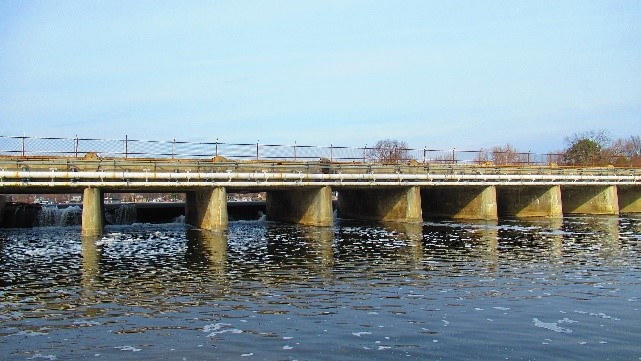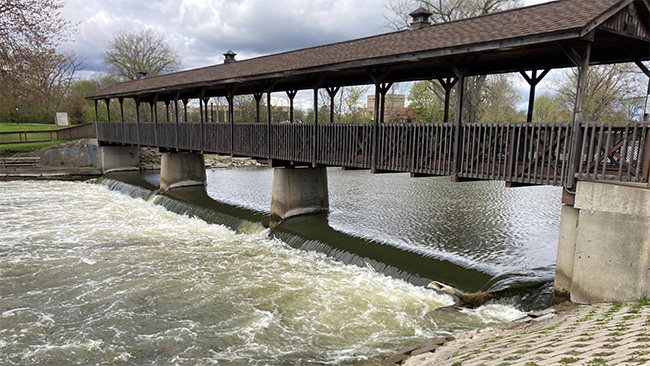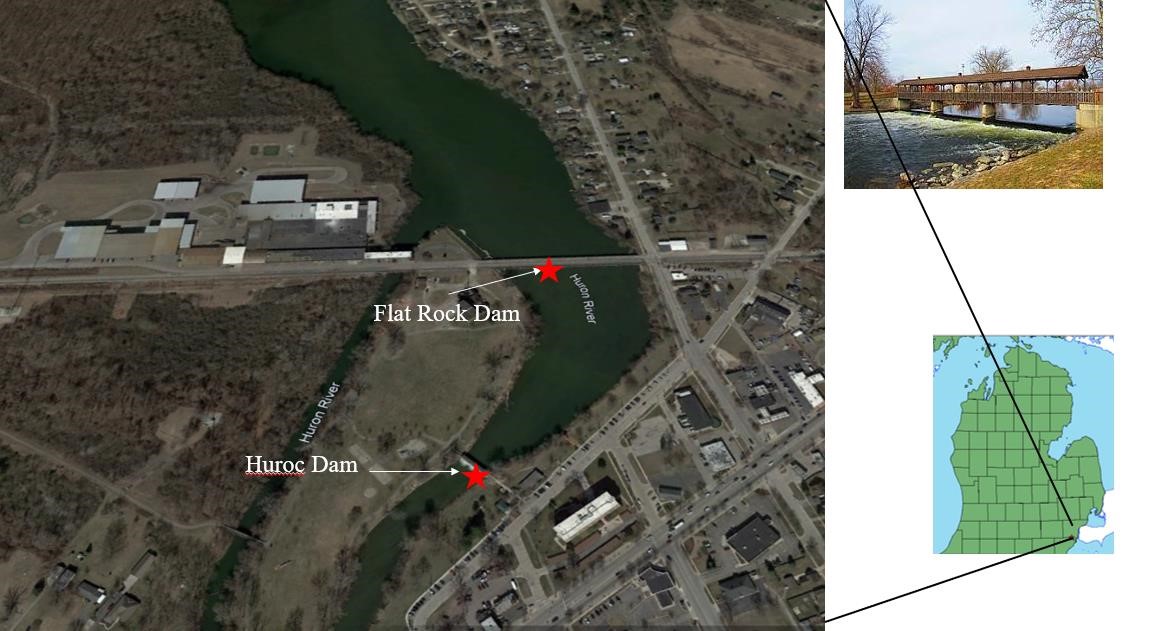Flat Rock/Huroc Dam Fish Passage Project

Flat Rock Dam

Huroc Dam
The Flat Rock and Huroc dams are located on the Huron River, MI and are the first significant fish passage barriers upstream from Lake Erie. The Flat Rock Dam is located immediately upstream of the West Huron River drive bridge/railroad bridge and has other infrastructure, including an oil/gas pipeline associated with it. The Huroc Dam is a low head dam just downstream of the Flat Rock Dam.

These two barriers restrict fish passage and limit production for a number of Lake Erie Committee (LEC) species of common concern including lake sturgeon, walleye, and white bass, and have downstream impacts to hydraulic connectivity and habitat. In addition, a number of species of concern including native mussel species such as snuffbox, elktoe, purple wartyback, and the wavy-rayed lampmussel, as well as their host-fish species; logperch, smallmouth bass, eastern sand darter, and spotted sucker are documented in this river system. This community of species may benefit from removing or reducing these barriers and adding hydraulic (water) connectivity back in the watershed.
Through an existing National Oceanic and Atmospheric Administration Fisheries Regional Partnership with the Great Lakes Fishery Commission (GLFC), the Huron-Clinton Metroparks, the Michigan Department of Natural Resources (MDNR), Huron River Watershed Council (HRWC), and City of Flat Rock were awarded a grant through the Great Lakes Restoration Initiative. This grant will be used to develop a feasibility study that considers alternatives for the Huroc and Flat Rock Dams that will benefit the community and natural habitats that surround it. Partners are focused on improved fish passage and reconnecting important tributary habitat to Great Lakes species while also minimizing the risk of sea lamprey infestation.
The Huron-Clinton Metroparks owns the Flat Rock Dam structure and the City of Flat Rock owns the Huroc Dam and adjacent parkland, and the organizations are working together with additional partners to determine the best solution for the future of these dams and the communities they impact.
This feasibility study will develop a number of alternatives for fish passage and will include exploration of environmental impacts to water quality and nutrient cycling upstream and downstream of the barriers, existing infrastructure (road, bridge, utilities) in the vicinity, land ownership, recreational usage, sediment transport, aquatic species impacts (both native and non-native) and contaminant risks for these alternatives. The US Fish and Wildlife Service (USFWS) Sea Lamprey Control Program is supportive of efforts to explore the feasibility of fish passage alternatives while minimizing risks of sea lamprey infestation in the stream and Lake Erie.
A consulting team led by GEI Consultants is conducting phase one of the project. Goals of the feasibility study include:
- Minimize the risk of sea lamprey–a parasitic invasive fish species–infestation to the extent possible and necessary
- Allow for the passage and travel of native species, such as lake sturgeon (Acipenser fulvescens), walleye (Sander vitreus), and white bass (Morone chrysops)
- Improve and connect natural habitats along the Huron River
- Reduce future risk of dam failures and possible downstream damage that could occur in the event of a failure.
- The current EGLE dam safety rating has classified the Flat Rock Dam as a high hazard potential dam. “High hazard potential” indicates a dam located in an area where a failure may cause serious damage to critical infrastructure, critically harm the environment, or where failure could cause potential loss of life.
The feasibility study will be conducted from spring 2023 to spring 2025. Main tasks include:
- Compiling and reviewing existing data related to the site (e.g., dam safety, utilities and other infrastructure, river and impoundment conditions, real estate evaluation, and archaeology)
- Developing alternative scenarios for dam disposition and cost estimates (i.e., no action taken, dam removal with full restoration, dam removal with partial restoration, partial dam removal)
- Evaluating challenges and opportunities for each alternative scenario
- Engaging and informing the community about the project while collecting feedback and answering questions
An initial public meeting was held on August 23, 2023 to introduce the project to community members and interested attendees. A recording of that meeting can be viewed here. A second public open house was held on March 6, 2025 to discuss the results of the draft feasibility study, and collect comments and questions. A third public meeting will be hosted by HCMA approximately 1-3 months after the open house, where partners will share feedback and answer questions.
As a part of the feasibility study, environmental data will be collected, including data such as sediment volume and bathymetry in the reservoir upstream, geotechnical data, wetland surveys, hydraulic and hydrological analyses, thermal data, site passability measures including channel width, slope, and maximum jump height. Additionally, biological data compiled from previous data collections in the vicinity will include presence of target fish species both upstream and downstream of dam sites and pre- and post-restoration fish community assessments.
Datasets will provide specifics on information collected and collection dates. Data will be collected in accordance with the procedures described in the Quality Assurance Project Plan. The data will be stored internally by partner agencies as well as on this GLFC website. The Metroparks also hosts a website with various restoration and improvement projects, and will post updates about this study and opportunities to attend public meetings on that page. That can be found here. The data will be available to the public either through this website or upon request within 60 days of data entry and validation, starting during the summer, 2023, through the summer 2026. Contact Jeff Tyson for more information or to make a data request. All future sub-awardees not identified in this plan will have as a condition of their contract acceptance of this data sharing plan. Any additional data sharing stipulations for future sub-awardees may be outlined at that time and described in their contract

